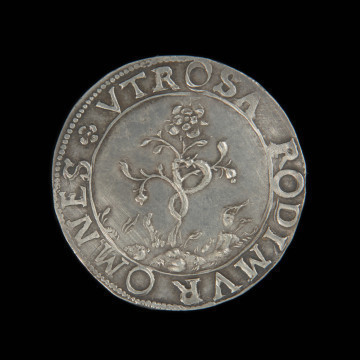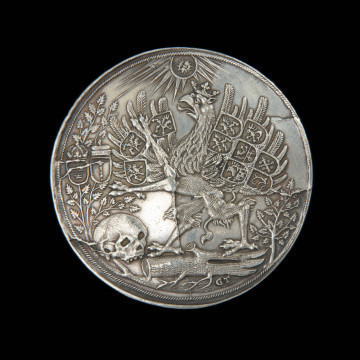
The 1/8 thaler on the death of Duke Philip II
1618
National Museum in Szczecin
Part of the collection: Pomeranian coins
The real heyday of occasional issues took place during the reign of Duke Philip II of Szczecin (1606-1618), a great patron of the arts and a collector. Coins were usually minted to commemorate the deceased dukes and significant figures from the House of Griffin. In 1617, a silver series was issued to commemorate the death of Prince George III (1582-1617). Philip's beloved brother died suddenly at the age of 35. The stamps feature original and exciting images and sentences not previously associated with death. No coin bears the likeness of the deceased Duke. The series of coins dedicated to the memory of George III included both high denominations - thalers and their multiples - intended for distinguished guests, and parts of thalers - orts (1/4 thaler) and half-orts (1/8 thaler), minted for the crowd gathered at the funeral. The floral compositions on the stamps of the thaler parts are very similar at first sight, but the content of the half-orts symbolises death and the orts resurrection. Plants played a vital role in the ruler's funeral ceremony, which lasted several weeks. The presence of plants characterised by permanent greenery symbolised eternal life and rebirth. Rue, periwinkle and myrtle were associated with young people's death. Their annual flowering cycle is an allegory of human existence and reflects the fragility of life. Flowers gave humans hope and reminded them of the resurrection and eternal life in paradise. The floral motif placed on the half-portrait is a symbol of misfortune and death. As a mysterious invisible force, the gust of wind refers to God, who shows here his destructive power. The content of the stamp is a literal interpretation of the passage from Psalm 103:15-16: man's days are like grass, and he blossoms like a flower in a meadow; all it takes is for the wind to blow on him he is gone. The iconography entirely corresponds to the inscription, and there is no doubt that nature is a divine element. The afore-mentioned floral motif placed on the orb, i.e., a radiant sun above a flower, is a symbol of rebirth, resurrection, to new life. The half-portrait comes from a German physician and collector, Professor Helmut Hahn's Pomeranian collection, sold in its entirety at auction in Berlin in 2013.
Genowefa Horoszko
Author / creator
Dimensions
cały obiekt: height: 0.8 mm, diameter: 26.8 mm
Object type
commemorative coin
Technique
minting
Material
silver
Creation time / dating
Creation / finding place
Owner
National Museum in Szczecin
Identification number
Location / status

1618
National Museum in Szczecin

1654
National Museum in Szczecin

1654
National Museum in Szczecin
DISCOVER this TOPIC
National Museum in Szczecin
DISCOVER this PATH
Educational path